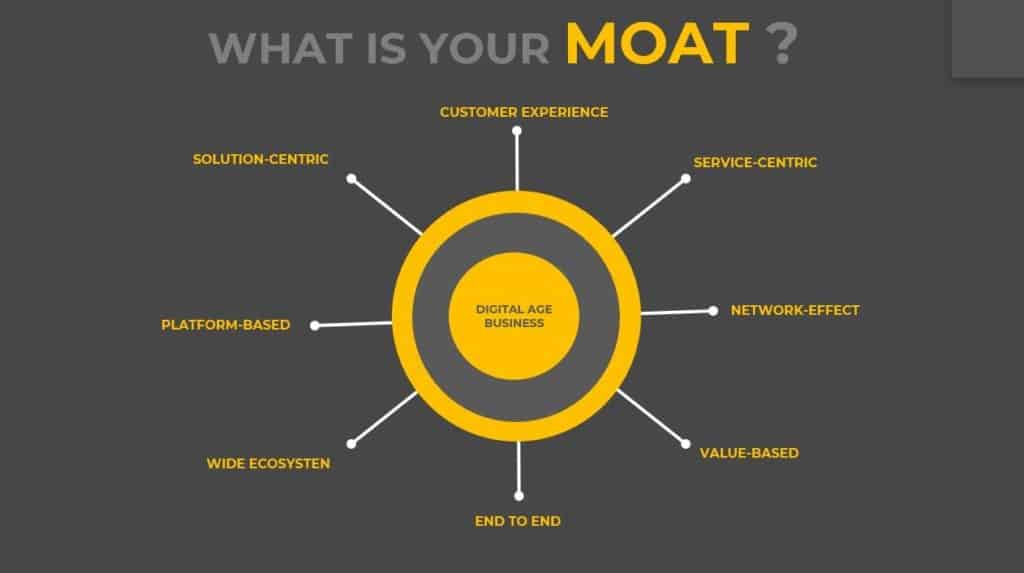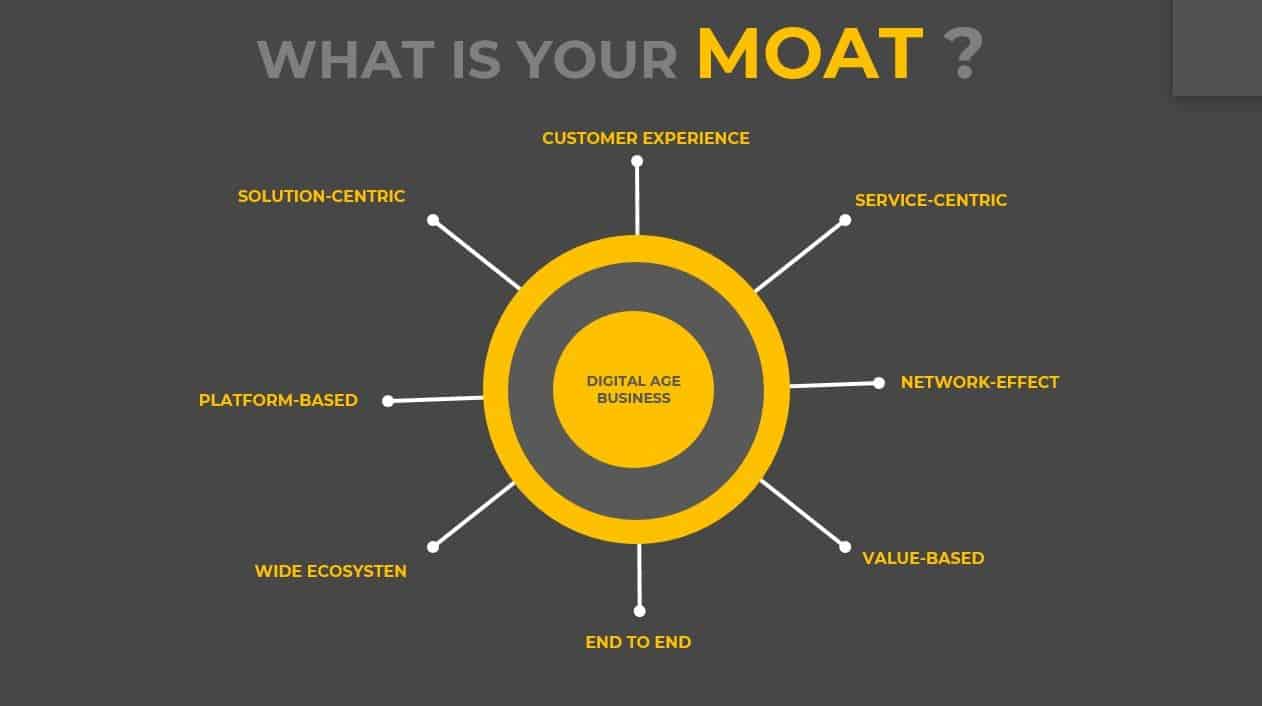Consider how Amazon’s extensive logistics network has become a significant barrier for competitors. In the entrepreneurial ecosystem, this kind of protective barrier is known as a moat.
Moats are essential because they safeguard your business from rivals, ensuring long-term growth and success. They come in various forms, like network effects, cost advantages, and intellectual property.
But what makes a moat truly effective, and how can you build one for your startup? Understanding this could be the key to attracting investors and securing your startup’s future.
Key Takeaways
- Moats are unique elements that protect startups from competition and ensure long-term success.
- Types of moats include network effects, switching costs, cost advantages, intellectual property, and brand loyalty.
- Moats create sustainable competitive advantages, making startups attractive to investors.
- Startups with multiple moats have increased defensibility and long-term prospects.
- Protecting a moat requires continuous innovation and strong customer relationships.
What is a Moat in the Startup World?
Starting a business is like building a castle. But without walls, your creation is vulnerable to rivals who can easily swoop in and take over. That’s where the concept of a ‘moat‘ comes in handy for startups.
In the startup world, a moat refers to the unique elements that protect your business from competition. It’s what makes your offering truly stand out and hard to replicate.
Imagine you’ve developed an incredible new product or service – without a moat, others can quickly copy what you’re doing, leaving you scrambling to stay afloat.
Building a strong moat is crucial for your startup’s long-term success and growth. It’s the secret sauce that keeps competitors at bay and attracts potential investors.
After all, why would anyone want to invest in a business that can easily be overrun by the big players?
Crafting an impenetrable moat involves honing in on the special features of your business that are tough to imitate. This could be advanced proprietary technology, a beloved brand with loyal followers, or exclusive partnerships that give you an edge.
By sharpening these unique strengths, you create barriers that make it difficult for rivals to encroach on your turf.
But a moat isn’t just about fending off the competition – it also reassures investors that your startup has what it takes to thrive in the long run.
When you demonstrate a sustainable competitive advantage, savvy investors are more likely to see your business as a worthwhile risk worth backing.
At the end of the day, a well-fortified moat is the key to ensuring your startup’s success and stability. It’s the difference between being the king of the castle or just another serf in the kingdom.
Types of Moats for Startups

Network Effects
The power of network effects can’t be overstated. As more people use your product or service, its value automatically increases.
Think about social media platforms – the more friends and connections you have, the more useful the network becomes. Harnessing this dynamic is a surefire way to build a truly defensible business.
Switching Costs
Deeply integrating your service into a customer’s daily workflow creates a powerful moat. The more their processes and data become reliant on your offering, the harder it is for them to switch to a competitor.
Imagine sophisticated accounting software that’s meticulously customized to a business—walking away from that would be a major headache.
Cost Advantages
If you can produce your product or deliver your service at a lower cost than rivals, you’ve got a major edge.
Economies of scale, proprietary tech, or streamlined operations – whatever gives you that cost advantage, use it to undercut competitors on price or enjoy fatter profit margins. This moat only strengthens as your business grows.
Intellectual Property
Patents, trademarks, and exclusive know-how act as formidable barriers to entry. When you’ve got unique innovations that competitors can’t duplicate, you carve out a defensible niche in the market.
Think about the cutting-edge tech startups – their ability to protect their IP is vital to maintaining their edge.
Brand Loyalty
Building a strong, trusted brand creates an almost unbreakable bond with customers. If your name is synonymous with quality and reliability, people will be far less inclined to switch, even if a competitor offers a similar product. The power of brand loyalty is the ultimate long-term moat.
Ultimately, mastering one or more of these moat types can transform your startup into an untouchable industry leader.
But remember, a moat isn’t a one-and-done proposition – it requires consistent effort to maintain and strengthen over time. Stay vigilant, and use these strategic advantages to dominate your market.
Real-World Examples of Startups with Strong Moats

Airbnb’s Network Effect Advantage
Airbnb stands out as a prime example of a startup that’s leveraged a powerful moat. They created a captivating network effect – the more users and hosts that joined their platform, the more valuable it became.
This made it incredibly challenging for competitors to replicate Airbnb’s expansive user base, giving them a significant competitive edge.
Uber’s Winning Combination
Uber’s success is rooted in their ability to build a strong brand and deliver a seamless user experience through cutting-edge technology.
Their innovative ride-sharing algorithm and extensive network of drivers set a high bar that newcomers struggled to match. This formidable combination made it exceedingly difficult for rivals to gain traction.
Spotify’s Curated Listening Experience
Spotify has established a remarkable moat by securing exclusive deals with record labels and developing personalized music recommendation algorithms.
This curated listening experience is tough for new streaming services to replicate, solidifying Spotify’s position as the go-to platform for music lovers.
Stripe’s Technological Superiority
Fintech startup Stripe has carved out a formidable moat through technological superiority. Their payment processing solution is simple, reliable, and easily integrates with various platforms.
Spotify’s relentless focus on developer experience and continuous innovation has kept competitors at bay, cementing their leadership in the industry.
Zoom’s Unmatched Ease of Use
Zoom’s rise to prominence in the video conferencing space is largely due to their user-friendly service and unwavering commitment to quality and reliability.
By consistently improving their features and maintaining a smooth user experience, Zoom has outpaced other players in the market, making it challenging for newcomers to gain a foothold.
The common thread among these successful startups is their ability to build and leverage powerful moats.
Whether it’s a network effect, technological superiority, or an unparalleled user experience, these companies have found ways to create significant barriers to entry for their competitors.
As a result, they’ve secured market dominance and positioned themselves for long-term growth and success.
The Importance of a Moat for Investors

Startups with strong moats are gold mines for investors. These companies have built formidable defenses that make it tough for competitors to encroach on their turf. And for investors, that translates to more secure and potentially lucrative returns.
Why do moats matter so much? Let’s dive in:
- Risk Mitigation: Startups with sturdy moats are less vulnerable to competitive threats. This lowers the risk of market share erosion, giving investors greater peace of mind.
- Higher Returns: Dominant market positions, enabled by moats, can lead to fatter profit margins and revenues over time. Investors love that kind of consistent growth.
- Longevity: Companies with durable moats are more likely to stand the test of time, providing steady returns for investors willing to play the long game.
- Valuation Premium: Startups with clear competitive advantages often demand higher valuations, making them attractive acquisition or IPO targets. Investors can capitalize on this.
- So how do you spot a startup with a real moat? Look for things like proprietary technology, strong brand recognition, or network effects. These are the telltale signs of a business that can maintain its edge.
Can a Startup Have Multiple Moats?
While a single moat can make a startup attractive, just imagine the possibilities when a company boasts multiple moats.
Picture a startup that not only has a strong brand identity, but also benefits from network effects, proprietary technology, and cost advantages.
Each of these moats reinforces the others, creating an impenetrable fortress that competitors will struggle to breach.
By diversifying your moats, you’re building layers of protection that safeguard your market position. A brand moat may attract loyal customers, while network effects can make your product indispensable as more users join.
Proprietary technology provides a unique selling point, and cost advantages ensure you can operate more efficiently than others. It’s a synergistic effect that amplifies the strength of your startup.
Having multiple moats also means you’re less vulnerable to market disruptions. If one moat weakens due to changing trends or new entrants, the others can still hold strong.
This resilience gives you the freedom to navigate the competitive landscape, knowing your startup is well-defended on multiple fronts.
In essence, multiple moats provide a robust defense mechanism, enhancing your startup’s longevity and appeal to investors.
Why settle for a single moat when you can erect an entire fortress to protect your venture?
How Can a Startup Protect Its Moat From Being Replicated?
In the fast-paced world of startups, maintaining a competitive edge can be a constant challenge. How can you ensure your startup’s secret sauce – its ‘moat’ – stays firmly in place, resisting imitation by rivals?
The key lies in a relentless pursuit of innovation and a deep understanding of your market.
Continuous innovation is crucial. By staying ahead of industry trends and consistently improving your product or service, you create a strong and enduring advantage.
Fostering a culture of creativity within your organization guarantees a steady stream of new ideas and improvements – your competitors will struggle to catch up.
Intellectual Property (IP) protection is another vital step. Securing patents, trademarks, and copyrights legally shields your innovations and brand identity. This makes it much harder for others to copy your core offerings.
Building strong, lasting relationships with your customers is just as important. Provide excellent service and keep them engaged – this loyalty makes it difficult for competitors to lure them away.
Operational efficiency is another moat-building strategy. Develop proprietary processes and systems that increase your efficiency and reduce costs. This creates barriers for competitors who can’t match your internal advantages.
Finally, don’t underestimate the power of data. Leverage analytics to gain deep insights into customer behavior and market trends. This intelligence allows you to stay one step ahead, anticipating the competition’s next moves.
